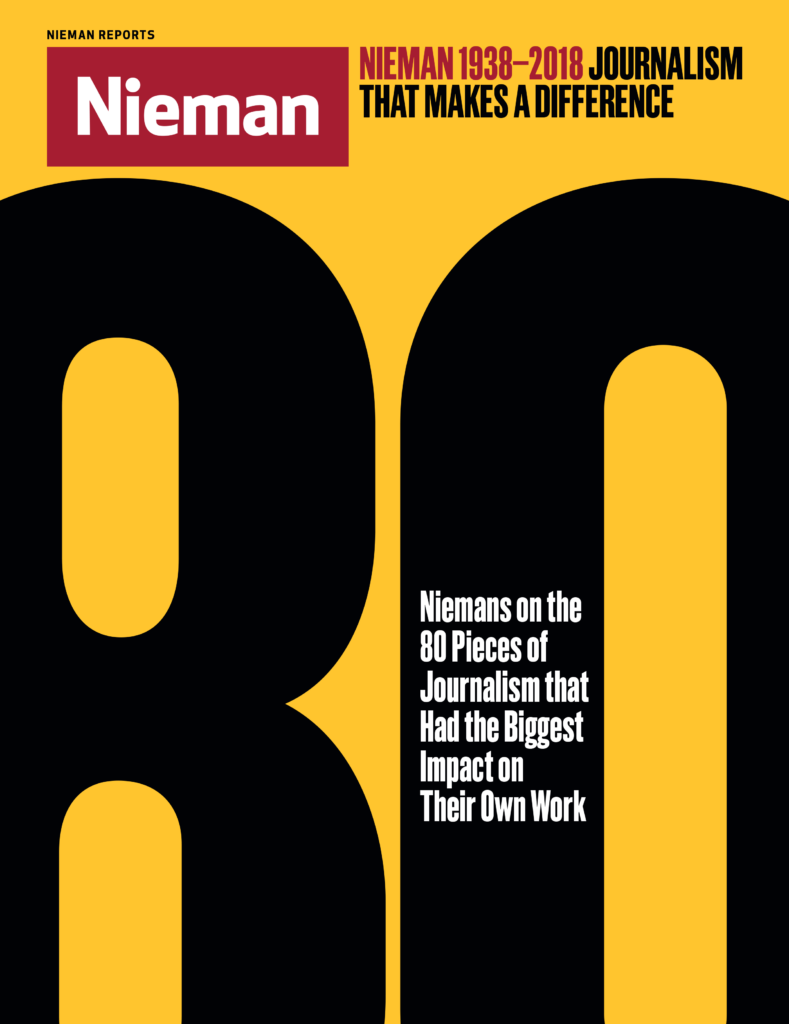
How are great journalists made? Often, it’s pieces of great journalism that help form them, influencing their lives or careers in an indelible way. To celebrate the Nieman Foundation for Journalism’s 80th anniversary in 2018, we asked Nieman Fellows to share works of journalism that in some way left a significant mark on them, their work or their beat, their country, or their culture. The result is what Nieman curator Ann Marie Lipinski calls “an accidental curriculum that has shaped generations of journalists.”
By the time I read “No Logo” in 2005 I had been working in advertising for five years, and came to question what my brain power was being used for. At the time I worked in a small ad agency near Tel Aviv. Clients included small real-estate companies and baby-clothing brands; as I tried for the umpteenth time to peddle a new suburban development, I asked myself, Why? Why was this work necessary? I certainly wasn’t the first ad-woman to have ever felt so, but I couldn’t put my malaise into words.
Klein gave me words. Her book is composed of four parts (No Space, No Choice, No Jobs, and No Logo), outlining how international corporations infiltrate every aspect of contemporary life; brand themselves for first-world customers while outsourcing jobs to the developing world; and use their vast resources to take over entire markets. It was an exhaustively researched evisceration of the world I was a part of, quickly weaponized by anti-globalization activists. I couldn’t stop talking about it.
Klein gave me another gift. The advertising industry does not look kindly on cogs questioning the machine; if you’re experiencing qualms, here’s a line of creatives who will replace you. But Klein showed me a path for using my critical tendencies to do good. The year I read her book, I left advertising for journalism. The change had been brewing for some time, but Klein supplied the ideological catalyst—and many useful anti-corporate arguments to hurl at anyone questioning the change I was making. Sanctimonious? Perhaps, but also very effective.
No Logo: Taking Aim at the Brand Bullies
By Naomi Klein
Picador USA, December 1999
Excerpt
For the longest time, the making of things remained, at least in principle, the heart of all industrialized economies. But by the eighties, pushed along by that decade’s recession, some of the most powerful manufacturers in the world had begun to falter. A consensus emerged that corporations were bloated, oversized; they owned too much, employed too many people, and were weighed down with too many things. The very process of producing—running one’s own factories, being responsible for tens of thousands of full-time, permanent employees—began to look less like the route to success and more like a clunky liability.
At around this same time a new kind of corporation began to rival the traditional all-American manufacturers for market share; these were the Nikes and Microsofts, and later, the Tommy Hilfigers and Intels. These pioneers made the bold claim that producing goods was only an incidental part of their operations, and that thanks to recent victories in trade liberalization and labour-law reform, they were able to have their products made for them by contractors, many of them overseas. What these companies produced primarily were not things, they said, but images of their brands. Their real work lay not in manufacturing but in marketing. This formula, needless to say, has proved enormously profitable, and its success has companies competing in a race toward weightlessness: whoever owns the least, has the fewest employees on the payroll and produces the most powerful images, as opposed to products, wins the race.
Copyright © 2000 by Naomi Klein. Reprinted by permission of ICM Partners.


